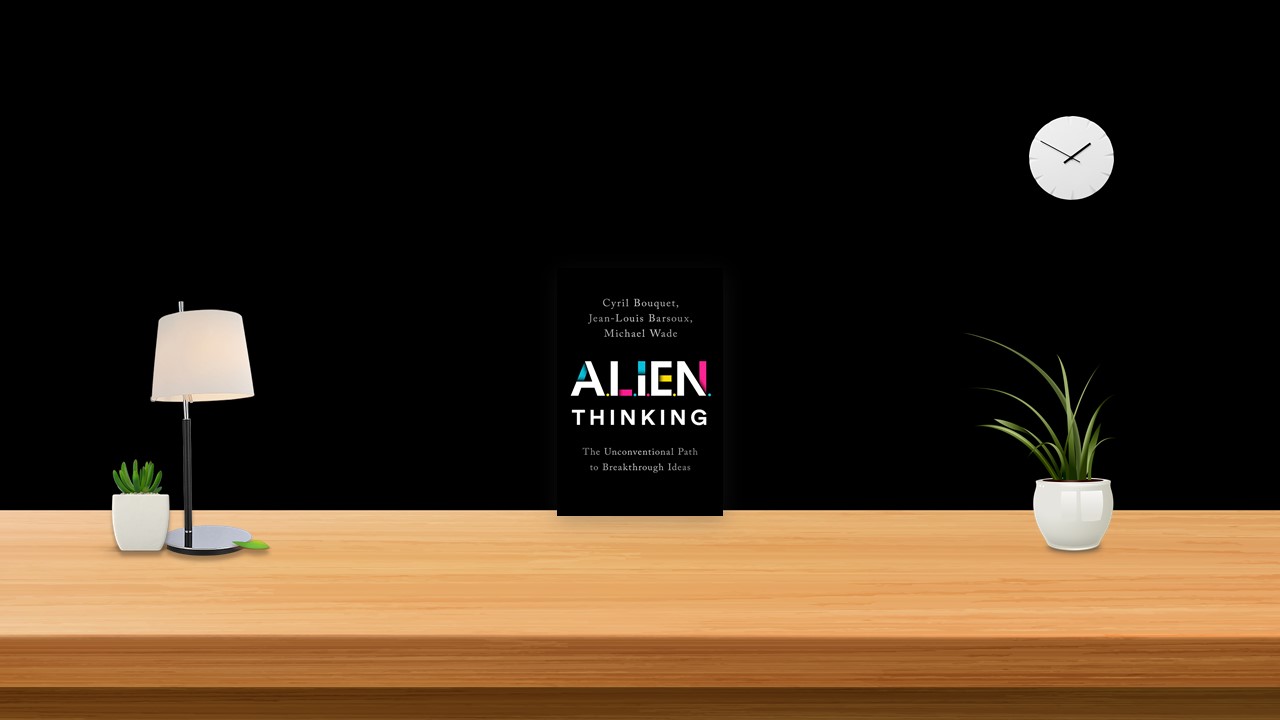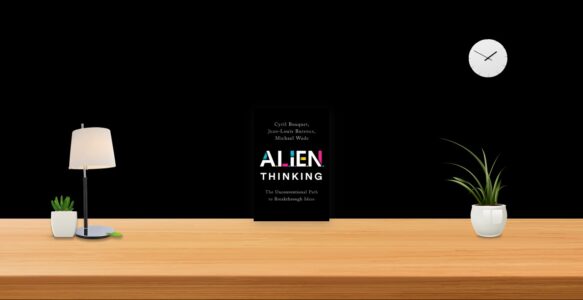ALIEN stands for Attention, Levitation, Imagination, Experimentation, and Navigation.
With the ALIEN, you’ll learn a set of innovation tools that can be applied to any endeavor. No longer do you need to wait for inspiration to strike—if it ever does. You can use the ALIEN model to catalyze original thinking and fast-track your ability to spot patterns and make the right mental connections.
Discovering the DNA of Originality
ALIEN thinkers, such as Billy Fischer and Teresa Hodge, are rebels with a cause. In addition to questioning what others take for granted, ALIEN thinkers are:
- Curious integrators, trying to understand what drives others and to make sense of their worlds.
- Ingenious analysts, combining their creative intelligence with the analytic tools at their disposal.
Although an ALIEN mindset can lead to breakthrough solutions, developing this state of mind isn’t easy. There are many psychological barriers to ALIEN thinking—biases that limit your ability to notice things, your creativity, and your willingness to switch course.
As illustrated by the case of James Dyson and his bagless vacuum cleaner, ALIEN thinkers and ideas are often regarded with mistrust by people with a stake in the status quo.
Despite the digitally enabled democratization of innovation during the last two decades, breakthrough solutions remain elusive, in part because existing innovation frameworks tend to be unrealistic, incomplete, misleading, or a combination of the three.
Attention: See the World with Fresh Eyes
Attention is the active effort of looking at the world to observe problems that need to be solved, opportunities worth addressing, and solutions that can be dramatically improved or revised.
Attention has two key attributes: narrowed selectivity—that is, focusing on certain things while withdrawing your focus from other things—and increased cognitive energy—that is, committing more mental energy to studying a particular thing, person, experience, or context.
When dealing with large volumes of data, it is easy (and very common) to miss or dismiss weak or ambiguous signals. For example, it was only recently that pet food companies began designing products to increase the emotional reward for their human customers.
Your conditioning—notably your professional training and work experience—can interfere with the quality of attention by channeling your focus in particular directions, impacting what you notice and blinding you to radical insights.
To think like an alien, you must set aside your preconceptions and open your mind to alternative takes on reality. To see the world as it is, not as you wish it to be, you can either zoom in or zoom out.
- To zoom in, use a close-up lens to observe the situation in more detail and pick up on nuances, incongruities, anomalies, and weak signals.
- To zoom out, use a wide-angle lens to take in the larger patterns and trends, and expand the scope of your attention.
- To see differently, you need to switch focus—to redirect your attention to the signals coming from fringe sources, people and things you might normally perceive as marginal. Lego achieved this by plugging in to the internet forums of its adult fans.
Levitation: Elevate Your Thinking
Levitation is the act of stepping back to regain perspective. It’s about distancing yourself from the activity itself to think more clearly. Levitation is not outward focused but inward focused and introspective.
Levitation may seem like a new and alien concept, but its roots stretch back to antiquity. In Japan, for example, the concept of ma (roughly meaning the space or time in between) is rooted in the ancient Shinto religion and is considered a driver of creativity. Science now recognizes that a mind “at rest” is far from quiet. In fact, the default mode network (DMN) is often more active than a mind that’s performing a task.
Levitation helps you overcome framing and action biases, prompting you to question your initial assumptions, redefine the problem you want to solve, uncover new insights, reflect on what really matters, and distinguish noise from weak signals.
Because Teresa Hodge took time to levitate—to try to understand the situations of her fellow inmates and their families—she was able to make sense of why so many women kept coming back to prison.
To innovate like an ALIEN thinker, you must leverage two forms of levitation:
- Time-outs: stepping back from the action and confusion to reflect consciously on your approach and how to redirect your efforts
- Time off: taking a mental or physical vacation from your current preoccupations to tap the power of the unfocused brain
Imagination: Produce Out-of-This-World Ideas
Imagination is about seeing. It’s the ability of your mind to produce original ideas by envisioning something that doesn’t exist.
Of the many barriers to original thinking, functional fixedness is one of the most common. This cognitive bias limits your ability to think creatively or imagine alternative uses for familiar objects or concepts.
ALIEN thinking avoids cognitive biases and prompts imaginative leaps by rejecting default responses and exploring novel alternatives. For example, ALIEN thinker Van Phillips resisted the prosthetics industry’s fixation on designing artificial limbs that resembled actual legs and feet. Instead, he focused on connecting the dots between objects that could provide the same (or better) functionality—diving boards, cheetah legs, and a C-shaped sword.
Imagination is a universal quality—a trait everyone displays at a very young age. Unfortunately, it’s also something most of us progressively lose over time. It is socialized out of us by our education systems.
To overcome the conditioning that values memorization over discovery, you need techniques that promote and revitalize your imagination. ALIEN thinkers approach problems with a childlike open mind. They also recognize the value of play in stimulating the imagination, because it is exploratory and nonjudgmental.
The most effective brainstorming seeks to raise questions, especially why questions and what-if questions.
Outsiders often find it easier to think like aliens and develop novel solutions. They are better able to connect disparate thoughts because they come to the table with fewer preconceptions than insiders.
Organizations can spark imaginative connections by assembling minds with diverse knowledge bases and perspectives.
Experimentation: Test Smarter to Learn Faster
Experimentation is the process of turning a promising idea into a workable solution that addresses a real need.
The top reason start-ups fail is that they offer something that nobody wants. Therefore, to establish whether an idea is desirable and viable, you must engage in experimentation.
As they experiment, ALIEN thinkers combine two seemingly contradictory qualities: total focus and total flexibility. By contrast, the conventional focus of most experimenters is on validation. This approach is geared to removing uncertainty, not to identifying possibility. As a result, focusing on validation often means missing out on unexpected insights
The case of Segway illustrates the drawbacks of persisting too long without critical input from potential customers. Internal iteration can take you only so far. A big risk, once you start testing your idea, is that well-established confirmation biases and sunk-cost effects will deaden your responsiveness to corrective feedback.
ALIEN thinkers use experiments to validate and investigate. As an ALIEN thinker, architect Frank Gehry welcomes surprises with his experiments. By creating multiple “shrek” models, he provokes strong reactions from clients that help him understand how they think. The process enables him to explore and learn from clients’ discomfort, which helps his ideas ferment and mature over time.
Whether you’re working alone or in a team, you need to think about how you interpret data and how to avoid biases. There are two ways to address these challenges: (1) let the data speak, and (2) seek out people who think differently than you.
Navigation: Maneuver to Soar… and to Avoid Being Shot Down
Navigation is about dealing with the external environment and adjusting to the forces that can make or break your solution.
Without buy-in from key decision-makers, your solution may not survive contact with the organization, investors, or industry partners. Steve Sasson’s experience at Kodak proves that it takes more than a breakthrough prototype to succeed.
When it comes to navigation, innovators often delude themselves in two ways: (1) they overestimate the ability of their breakthrough solution to speak for itself and succeed on its own merits, and (2) they underestimate the potential hostility of the environment.
Revolutionary products can easily be derailed by unforeseen or unforeseeable external forces. But what often comes as the biggest shock for innovators is internal opposition from the very organization that stands to benefit most from the breakthrough.
To navigate safely, ALIEN thinkers map the sources of friction and then work to neutralize them in two ways: (1) by using camouflage to evade detection and the destructive judgment of others, especially during the project’s early stages; and (2) by strengthening their ability to absorb hits from critics and opponents.
One way to minimize attacks on your project is by stressing its links with the past. Another way is to emphasize how the idea aligns with the organization’s core values and goals.
To thrive, you need to identify positive forces to help your idea gain traction. You must also find original ways of harnessing those forces to ensure that everyone benefits. You can also thrive by seizing unexpected and overlooked opportunities. KidZania cofounder López did this by deciding to expand into Asia before tackling the US market.
The ALIEN Model in Action
ALIEN thinking is not something you do at a particular time, in a dedicated space, with clear rules and staple props like whiteboards and sticky notes. It’s something you can call on at any time, whenever you hit a roadblock, to turn ideas into solutions.
In practice, the process of discovering breakthrough solutions is very fluid. Although attention may be a logical starting point for innovation, beginning with the other components of ALIEN thinking is perfectly valid, too. Innovation has multiple entry points.
Just as you can start anywhere in the creative process, you can also proceed in any direction and then switch focus as required.
Although the order is flexible, you must touch each base at least once, because different elements neutralize different biases. Each element adds value. Disregarding even one can lead you to focus on the wrong problem, idea, or solution.
By recognizing the importance of flexible strategies, the ALIEN model serves as a more realistic guide to developing breakthrough solutions than other methodologies. It accepts that the innovation process is convoluted and that creativity is a journey of sensemaking.


